2023年中考英语语法复习 非谓语动词课件(共40张PPT)
文档属性
| 名称 | 2023年中考英语语法复习 非谓语动词课件(共40张PPT) |  | |
| 格式 | zip | ||
| 文件大小 | 103.9KB | ||
| 资源类型 | 教案 | ||
| 版本资源 | 人教新目标(Go for it)版 | ||
| 科目 | 英语 | ||
| 更新时间 | 2022-07-28 08:45:50 | ||
图片预览


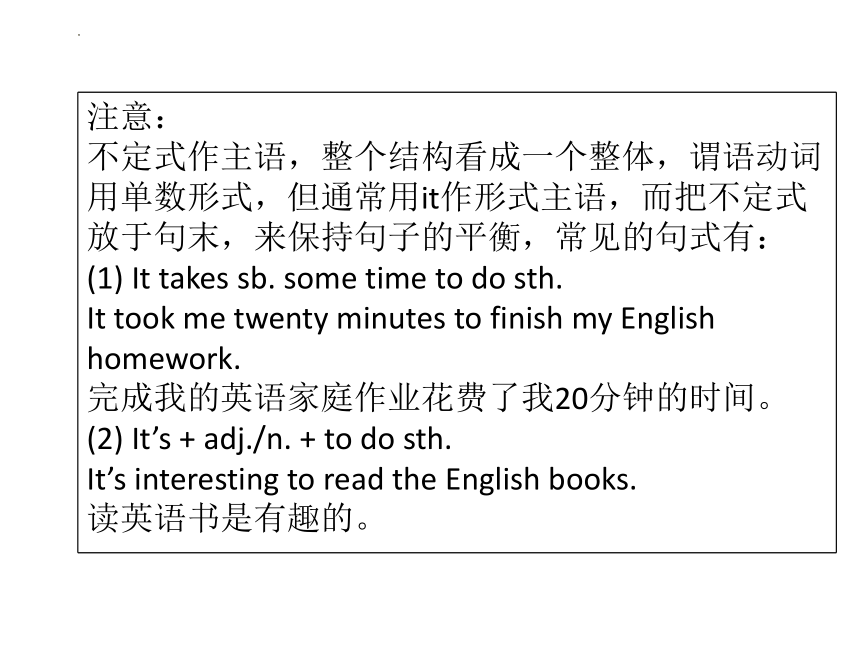
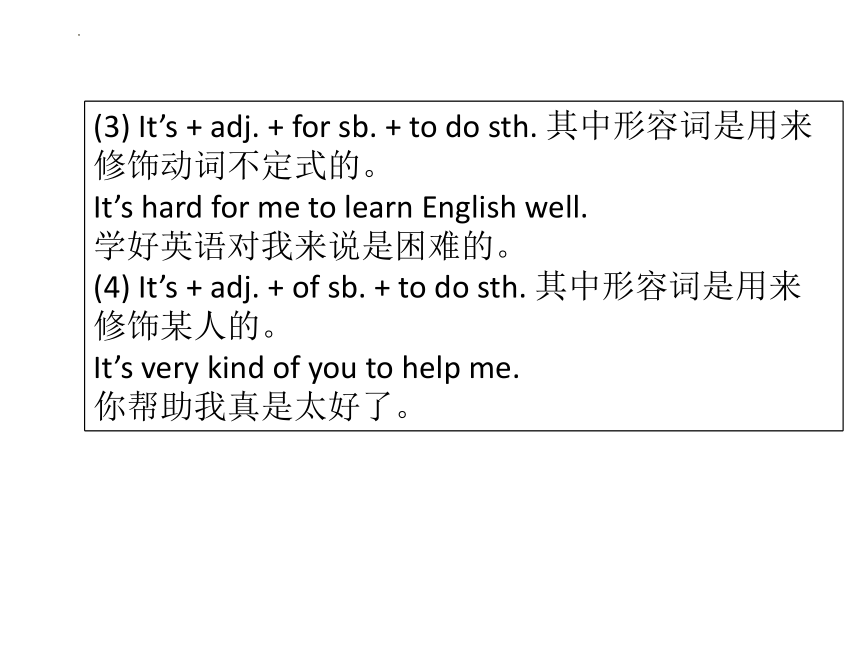
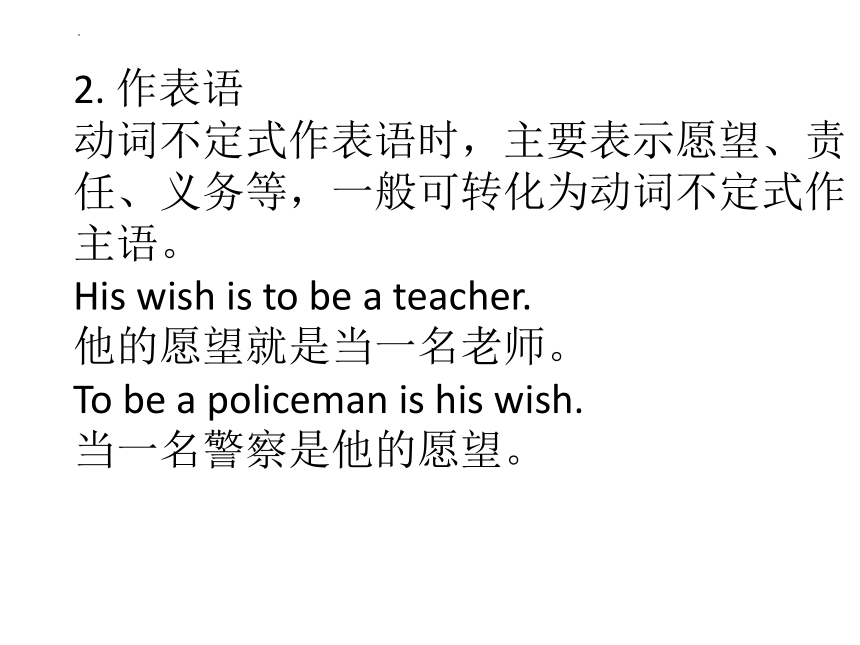
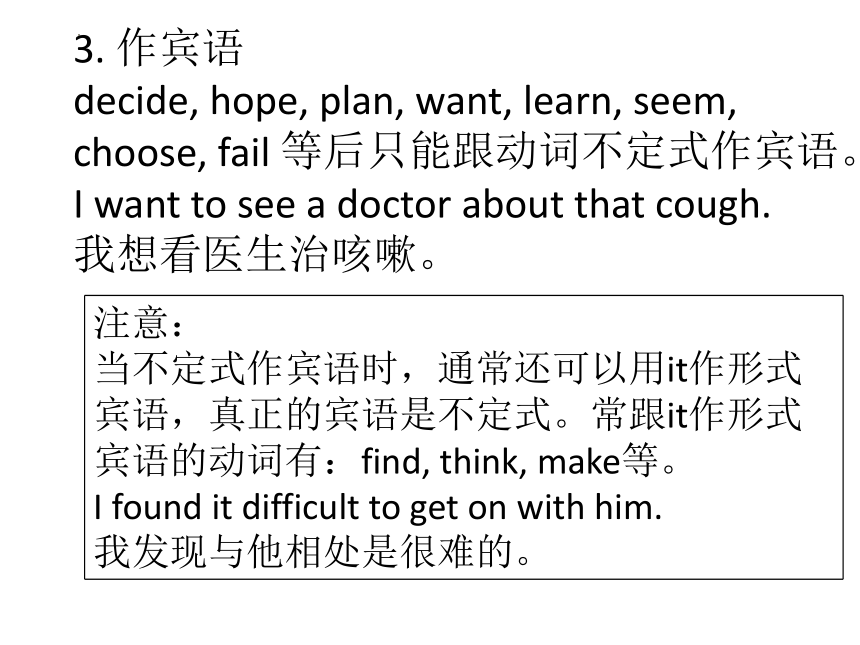
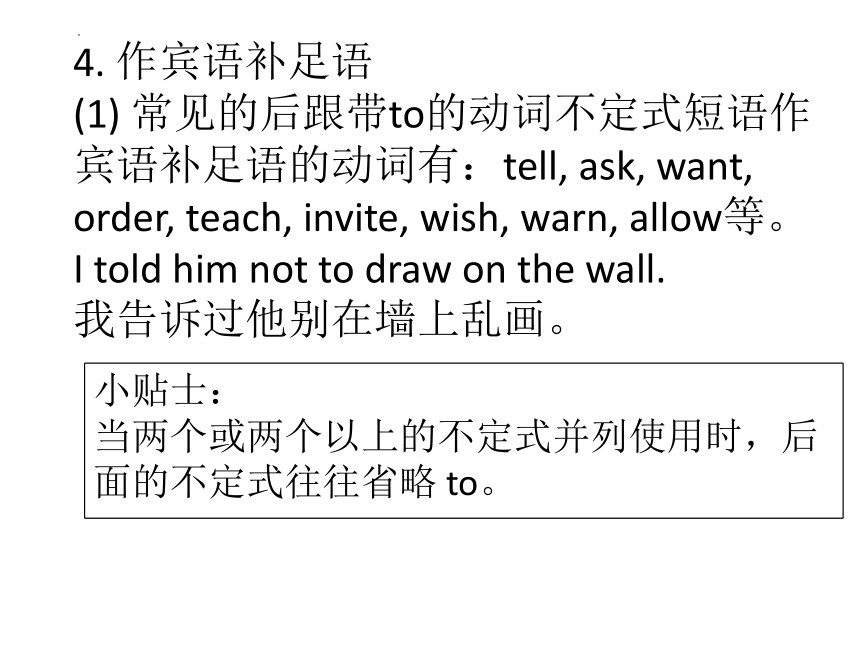
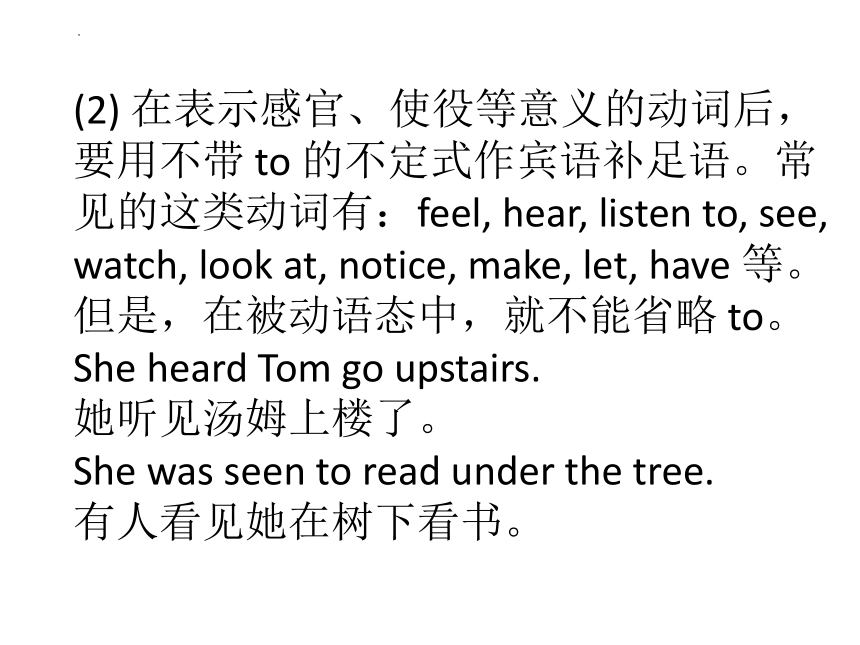



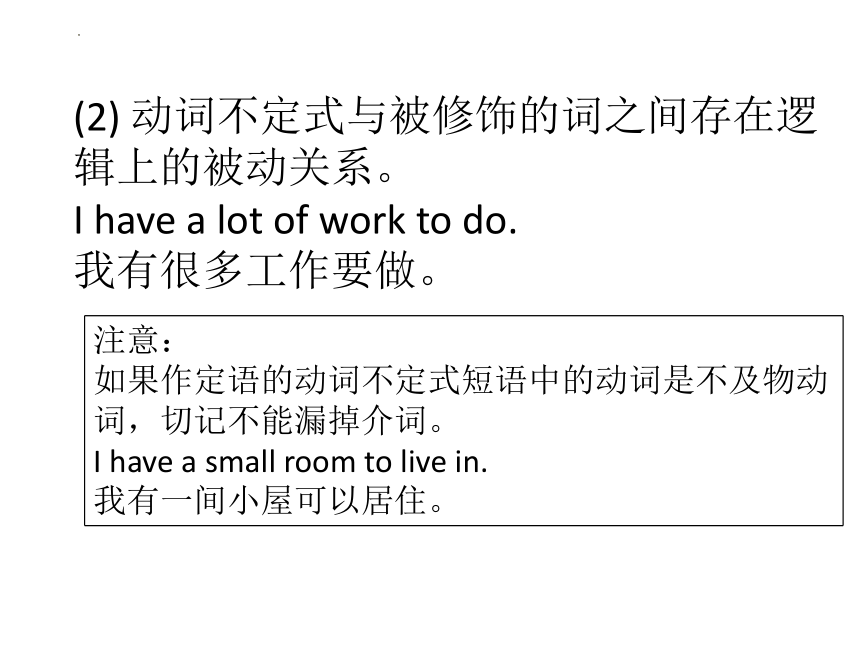
文档简介
(共40张PPT)
中考英语总复习
非谓语动词
九年级英语备课组
■ 考点一 动词不定式
动词不定式是动词的一种非限定形式,有加 to 和省略 to 两种形式,可以在句中作主语、表语、定语、宾语补足语、状语等成分。
1. 作主语
To travel around China is my dream.
环游中国是我的梦想。
注意:
不定式作主语,整个结构看成一个整体,谓语动词用单数形式,但通常用it作形式主语,而把不定式放于句末,来保持句子的平衡,常见的句式有:
(1) It takes sb. some time to do sth.
It took me twenty minutes to finish my English homework.
完成我的英语家庭作业花费了我20分钟的时间。
(2) It’s + adj./n. + to do sth.
It’s interesting to read the English books.
读英语书是有趣的。
(3) It’s + adj. + for sb. + to do sth. 其中形容词是用来修饰动词不定式的。
It’s hard for me to learn English well.
学好英语对我来说是困难的。
(4) It’s + adj. + of sb. + to do sth. 其中形容词是用来修饰某人的。
It’s very kind of you to help me.
你帮助我真是太好了。
2. 作表语
动词不定式作表语时,主要表示愿望、责任、义务等,一般可转化为动词不定式作主语。
His wish is to be a teacher.
他的愿望就是当一名老师。
To be a policeman is his wish.
当一名警察是他的愿望。
3. 作宾语
decide, hope, plan, want, learn, seem, choose, fail 等后只能跟动词不定式作宾语。
I want to see a doctor about that cough.
我想看医生治咳嗽。
注意:
当不定式作宾语时,通常还可以用it作形式宾语,真正的宾语是不定式。常跟it作形式宾语的动词有:find, think, make等。
I found it difficult to get on with him.
我发现与他相处是很难的。
4. 作宾语补足语
(1) 常见的后跟带to的动词不定式短语作宾语补足语的动词有:tell, ask, want, order, teach, invite, wish, warn, allow等。
I told him not to draw on the wall.
我告诉过他别在墙上乱画。
小贴士:
当两个或两个以上的不定式并列使用时,后面的不定式往往省略 to。
(2) 在表示感官、使役等意义的动词后,要用不带 to 的不定式作宾语补足语。常见的这类动词有:feel, hear, listen to, see, watch, look at, notice, make, let, have 等。但是,在被动语态中,就不能省略 to。
She heard Tom go upstairs.
她听见汤姆上楼了。
She was seen to read under the tree.
有人看见她在树下看书。
(3) 在动词 help 之后,不定式作宾语补足语,可以带 to,也可以不带 to。
She helped him (to) choose some new clothes.
她帮他挑了一些新衣服。
巧记:
不定式作宾语补足语时省略 to 的口诀
一感:feel
二听:hear, listen to
三让:let, make, have
四看:see, watch, notice, look at
半帮助:help
注意:
不用不定式作宾语补足语的动词有 hope, agree, demand, suggest, insist 等。
【误】I hope you to come earlier.
【正】I hope you come earlier.
5. 作定语
动词不定式短语作定语时,应放在修饰词之后。
(1) 被修饰的词与不定式有逻辑上的主动关系。
It is said that a Chinese ruler called Shen Nong was the first to discover tea as a drink.
据说一位叫神农的中国统治者第一个发现茶是一种饮料。
(2) 动词不定式与被修饰的词之间存在逻辑上的被动关系。
I have a lot of work to do.
我有很多工作要做。
注意:
如果作定语的动词不定式短语中的动词是不及物动词,切记不能漏掉介词。
I have a small room to live in.
我有一间小屋可以居住。
(3) 不定式说明它所修饰的名词或代词的内容。不定式与被修饰词之间是同位关系。
What a pity! And we will have no chance to go there.
太可惜了!我们将没机会去那里了。
6. 作状语
动词不定式短语可以作目的状语、原因状语、结果状语和条件状语等。
I come to see you.
我来看你了。(目的状语)
Jim will be so happy to see you.
吉姆将会很高兴见到你。(原因状语)
I hurried to the playground only to find nobody there.
我匆忙赶到操场上,结果发现没有人在那儿。(结果状语)
To turn to the right, you could find the bookshop.
(如果)向右拐,你就会找到书店。(条件状语)
7. “疑问词 + 动词不定式”结构可以在句子中作主语、宾语、表语等成分。
She asked me when to start. 她问我什么时候出发。
拓展:含不定式的特殊句式
1. Why not + 不带 to 的不定式 ...
2. had better (+ not) + 不带 to 的不定式 ...
3. would rather + 不带 to 的不定式 ... + than + 不带 to 的不定式 ...
4. too ... to + 动词原形 + ...
5. ... enough to + 动词原形 + ...
6. There be ... to + 动词原形 + ...
对点集训
用所给单词的适当形式填空。
1. Reading is a good way __________ (learn) English.
2. It’s too hot outside. I would rather __________ (stay) at home than __________ (go) out.
3. It’s important for us __________ (protect) the wild animals.
4. Our teacher often tells us __________ (swim) in the river. It’s dangerous.
to learn
stay
go
to protect
not to swim
5. All the Chinese people must work hard ________ (realize) China Dream.
6. Students should learn how __________ (solve) problems.
to realize
to solve
■ 考点二 动名词
在形式上,动名词与现在分词一样。但它相当于一个动词性的名词,它具有名词的绝大多数特征,可作主语、宾语、表语、定语、宾语补足语等成分。
1. 作主语
(1) 动名词作主语时,有时可以用it作形式主语,而把真正的主语后置。
Getting up early is good for your health.
= It is good for your health getting up early.
早起对你的健康有益。
(2) 动名词作主语时,谓语动词要用第三人称单数形式。
Smoking is harmful. 吸烟是有害的。
2. 作表语
动名词作表语可以转换为动名词作主语。
The nurse’s job is looking after the patients.
= Looking after the patients is the nurse’s job.
护士的工作就是照顾病人。
3. 作宾语
(1) 有些动词后面必须跟动名词作宾语,而不能跟不定式。
常见的这类动词有mind, finish, enjoy, practise, keep, miss, consider, suggest等。另外,动名词还可以作介词的宾语。
Would you mind my smoking
你介意我抽烟吗?
(2) 常见的后接动名词作宾语的短语
能接动名词作宾语的短语很多,初中阶段常见的有:be busy (忙于),be worth (值得),can’t help (禁不住),give up (放弃),be/get used to (习惯于), stop /prevent/keep ... from (阻止),look forward to (盼望),feel like (想要),think of (考虑),be good at (擅长),be interested in (对……感兴趣),succeed in (成功)等。
巧记:
只能跟动名词作宾语的动词或短语列举如下:
完成、实践、值得、忙
(finish, practise, be worth, be busy)
继续、习惯、放弃
(keep, be/get used to, give up)
考虑、建议、不禁、想要
(consider, suggest, can’t help, feel like)
喜欢、思念、介意
(enjoy, miss, mind)
4. 作定语
动名词作定语,表明它所修饰的词的用途、所属关系等,一般置于被修饰词前。
He slept in the sleeping bag.
他在睡袋里睡觉。
对点集训
用所给单词的适当形式填空。
1. Would you mind __________ (open) the window It’s very hot.
2. __________ (be) honest is the first thing people should learn.
3. There is an old saying “Seeing is __________ (believe)”. Have you ever heard it
4. She bought a new __________ (wash) machine yesterday.
opening
Being
believing
washing
5. Can you finish __________ (read) these books before 10 o’clock
6. Thank you for __________ (tell) me the news.
reading
telling
■ 考点三 分词
分词分为现在分词和过去分词两种。现在分词具有主动和进行的含义,而过去分词则具有被动和已经完成的含义。
1. 作定语
现在分词作定语时,单个的现在分词修饰名词时,常前置。现在分词短语作定语,常常置于被修饰词之后。过去分词作定语时,可以置于名词前,也可以置于名词后。
Do you know the girl standing under the tree
你认识站在树下的那个女孩吗?
The broken cup needs repairing.
那个破杯子需要修补。
注意:
以 -ed 形式结尾的形容词通常修饰人,以 -ing 形式结尾的形容词通常用于修饰物。
The news made all of us excited.
这个消息使我们都很兴奋。
2. 作表语
分词作表语,一般表示主语的特征和属性。
The result is surprising.
结果是令人吃惊的。
The vase is broken.
花瓶破了。
3. 作宾语补足语
(1) see, watch, hear, keep, find, notice等动词后可跟分词作宾语补足语。现在分词作宾语补足语,表示动作正在进行,句子的宾语是现在分词的逻辑主语,它们之间存在主动关系。而过去分词作宾语补足语时,与宾语之间是被动关系。
I found him reading a novel.
我发现他在看小说。
You must keep your eyes shut for just a minute.
你必须闭上眼睛,仅仅一会儿工夫就行。
(2) have/get sth. done表示“请别人做某事”,其中的过去分词作宾语补足语,与宾语之间是被动关系。
I’ll have my hair cut tomorrow.
明天我将找人给我理发。
I must get my bike repaired.
我必须请人修理我的自行车。
4. 作状语
分词作状语,主要表示时间、原因、条件、结果、伴随状况等。
They went out of the office, talking and laughing.
他们有说有笑地走出了办公室。(伴随状语)
The car, hit badly, can’t move at all.
那车被撞得很严重,一点儿都不能移动了。(原因状语)
对点集训
用所给单词的适当形式填空。
1. __________ (see) the cat, the mouse ran off.
2. The teacher came in, __________ (follow) by some students.
3. I have my bad teeth __________ (pull) out yesterday.
4. Who is the boy in a white T-shirt __________ (stand) under the tree
Seeing
followed
pulled
standing
5. We must drink __________ (boil) water and eat cooked food.
6. I found a letter __________ (lie) on the floor when I came into the classroom.
boiled
lying
■ 考点四 特殊动词的特殊用法
有些动词后加不定式或动名词作宾语有两种截然不同的含义。如:
1. go on to do sth. 接着做另一件事
go on doing sth. 继续做同一件事
2. forget to do sth. 忘记去做某事
forget doing sth. 忘记做过某事
3. remember to do sth. 记着去做某事
remember doing sth. 记着做过某事了
4. stop to do sth. 停下手头的事去做另一件事
stop doing sth. 停止正在做着的事情
5. try to do sth. 设法或努力做某事
try doing sth. 试着做某事
6. mean to do sth. 打算做某事
mean doing sth. 意味着做某事
7. allow sb. to do sth. 允许某人做某事
allow doing sth. 允许做某事
8. regret to do sth. 对要做的事遗憾(未做)
regret doing sth. 对做过的事遗憾,后悔(已做)
对点集训
用所给单词的适当形式填空。
1. You must stop __________ (eat) fast food. It’s not good for your health.
2. I forgot __________ (bring) my dictionary. Could I use yours
3. She goes on __________ (study) even though she is sick.
4. You should try __________ (work) hard, if you want to get good grades.
eating
to bring
studying
to work
5. Community service means __________ (do) jobs for the public.
6. Remember __________ (turn) off the lights when you leave the room, please.
doing
to turn
中考英语总复习
非谓语动词
九年级英语备课组
■ 考点一 动词不定式
动词不定式是动词的一种非限定形式,有加 to 和省略 to 两种形式,可以在句中作主语、表语、定语、宾语补足语、状语等成分。
1. 作主语
To travel around China is my dream.
环游中国是我的梦想。
注意:
不定式作主语,整个结构看成一个整体,谓语动词用单数形式,但通常用it作形式主语,而把不定式放于句末,来保持句子的平衡,常见的句式有:
(1) It takes sb. some time to do sth.
It took me twenty minutes to finish my English homework.
完成我的英语家庭作业花费了我20分钟的时间。
(2) It’s + adj./n. + to do sth.
It’s interesting to read the English books.
读英语书是有趣的。
(3) It’s + adj. + for sb. + to do sth. 其中形容词是用来修饰动词不定式的。
It’s hard for me to learn English well.
学好英语对我来说是困难的。
(4) It’s + adj. + of sb. + to do sth. 其中形容词是用来修饰某人的。
It’s very kind of you to help me.
你帮助我真是太好了。
2. 作表语
动词不定式作表语时,主要表示愿望、责任、义务等,一般可转化为动词不定式作主语。
His wish is to be a teacher.
他的愿望就是当一名老师。
To be a policeman is his wish.
当一名警察是他的愿望。
3. 作宾语
decide, hope, plan, want, learn, seem, choose, fail 等后只能跟动词不定式作宾语。
I want to see a doctor about that cough.
我想看医生治咳嗽。
注意:
当不定式作宾语时,通常还可以用it作形式宾语,真正的宾语是不定式。常跟it作形式宾语的动词有:find, think, make等。
I found it difficult to get on with him.
我发现与他相处是很难的。
4. 作宾语补足语
(1) 常见的后跟带to的动词不定式短语作宾语补足语的动词有:tell, ask, want, order, teach, invite, wish, warn, allow等。
I told him not to draw on the wall.
我告诉过他别在墙上乱画。
小贴士:
当两个或两个以上的不定式并列使用时,后面的不定式往往省略 to。
(2) 在表示感官、使役等意义的动词后,要用不带 to 的不定式作宾语补足语。常见的这类动词有:feel, hear, listen to, see, watch, look at, notice, make, let, have 等。但是,在被动语态中,就不能省略 to。
She heard Tom go upstairs.
她听见汤姆上楼了。
She was seen to read under the tree.
有人看见她在树下看书。
(3) 在动词 help 之后,不定式作宾语补足语,可以带 to,也可以不带 to。
She helped him (to) choose some new clothes.
她帮他挑了一些新衣服。
巧记:
不定式作宾语补足语时省略 to 的口诀
一感:feel
二听:hear, listen to
三让:let, make, have
四看:see, watch, notice, look at
半帮助:help
注意:
不用不定式作宾语补足语的动词有 hope, agree, demand, suggest, insist 等。
【误】I hope you to come earlier.
【正】I hope you come earlier.
5. 作定语
动词不定式短语作定语时,应放在修饰词之后。
(1) 被修饰的词与不定式有逻辑上的主动关系。
It is said that a Chinese ruler called Shen Nong was the first to discover tea as a drink.
据说一位叫神农的中国统治者第一个发现茶是一种饮料。
(2) 动词不定式与被修饰的词之间存在逻辑上的被动关系。
I have a lot of work to do.
我有很多工作要做。
注意:
如果作定语的动词不定式短语中的动词是不及物动词,切记不能漏掉介词。
I have a small room to live in.
我有一间小屋可以居住。
(3) 不定式说明它所修饰的名词或代词的内容。不定式与被修饰词之间是同位关系。
What a pity! And we will have no chance to go there.
太可惜了!我们将没机会去那里了。
6. 作状语
动词不定式短语可以作目的状语、原因状语、结果状语和条件状语等。
I come to see you.
我来看你了。(目的状语)
Jim will be so happy to see you.
吉姆将会很高兴见到你。(原因状语)
I hurried to the playground only to find nobody there.
我匆忙赶到操场上,结果发现没有人在那儿。(结果状语)
To turn to the right, you could find the bookshop.
(如果)向右拐,你就会找到书店。(条件状语)
7. “疑问词 + 动词不定式”结构可以在句子中作主语、宾语、表语等成分。
She asked me when to start. 她问我什么时候出发。
拓展:含不定式的特殊句式
1. Why not + 不带 to 的不定式 ...
2. had better (+ not) + 不带 to 的不定式 ...
3. would rather + 不带 to 的不定式 ... + than + 不带 to 的不定式 ...
4. too ... to + 动词原形 + ...
5. ... enough to + 动词原形 + ...
6. There be ... to + 动词原形 + ...
对点集训
用所给单词的适当形式填空。
1. Reading is a good way __________ (learn) English.
2. It’s too hot outside. I would rather __________ (stay) at home than __________ (go) out.
3. It’s important for us __________ (protect) the wild animals.
4. Our teacher often tells us __________ (swim) in the river. It’s dangerous.
to learn
stay
go
to protect
not to swim
5. All the Chinese people must work hard ________ (realize) China Dream.
6. Students should learn how __________ (solve) problems.
to realize
to solve
■ 考点二 动名词
在形式上,动名词与现在分词一样。但它相当于一个动词性的名词,它具有名词的绝大多数特征,可作主语、宾语、表语、定语、宾语补足语等成分。
1. 作主语
(1) 动名词作主语时,有时可以用it作形式主语,而把真正的主语后置。
Getting up early is good for your health.
= It is good for your health getting up early.
早起对你的健康有益。
(2) 动名词作主语时,谓语动词要用第三人称单数形式。
Smoking is harmful. 吸烟是有害的。
2. 作表语
动名词作表语可以转换为动名词作主语。
The nurse’s job is looking after the patients.
= Looking after the patients is the nurse’s job.
护士的工作就是照顾病人。
3. 作宾语
(1) 有些动词后面必须跟动名词作宾语,而不能跟不定式。
常见的这类动词有mind, finish, enjoy, practise, keep, miss, consider, suggest等。另外,动名词还可以作介词的宾语。
Would you mind my smoking
你介意我抽烟吗?
(2) 常见的后接动名词作宾语的短语
能接动名词作宾语的短语很多,初中阶段常见的有:be busy (忙于),be worth (值得),can’t help (禁不住),give up (放弃),be/get used to (习惯于), stop /prevent/keep ... from (阻止),look forward to (盼望),feel like (想要),think of (考虑),be good at (擅长),be interested in (对……感兴趣),succeed in (成功)等。
巧记:
只能跟动名词作宾语的动词或短语列举如下:
完成、实践、值得、忙
(finish, practise, be worth, be busy)
继续、习惯、放弃
(keep, be/get used to, give up)
考虑、建议、不禁、想要
(consider, suggest, can’t help, feel like)
喜欢、思念、介意
(enjoy, miss, mind)
4. 作定语
动名词作定语,表明它所修饰的词的用途、所属关系等,一般置于被修饰词前。
He slept in the sleeping bag.
他在睡袋里睡觉。
对点集训
用所给单词的适当形式填空。
1. Would you mind __________ (open) the window It’s very hot.
2. __________ (be) honest is the first thing people should learn.
3. There is an old saying “Seeing is __________ (believe)”. Have you ever heard it
4. She bought a new __________ (wash) machine yesterday.
opening
Being
believing
washing
5. Can you finish __________ (read) these books before 10 o’clock
6. Thank you for __________ (tell) me the news.
reading
telling
■ 考点三 分词
分词分为现在分词和过去分词两种。现在分词具有主动和进行的含义,而过去分词则具有被动和已经完成的含义。
1. 作定语
现在分词作定语时,单个的现在分词修饰名词时,常前置。现在分词短语作定语,常常置于被修饰词之后。过去分词作定语时,可以置于名词前,也可以置于名词后。
Do you know the girl standing under the tree
你认识站在树下的那个女孩吗?
The broken cup needs repairing.
那个破杯子需要修补。
注意:
以 -ed 形式结尾的形容词通常修饰人,以 -ing 形式结尾的形容词通常用于修饰物。
The news made all of us excited.
这个消息使我们都很兴奋。
2. 作表语
分词作表语,一般表示主语的特征和属性。
The result is surprising.
结果是令人吃惊的。
The vase is broken.
花瓶破了。
3. 作宾语补足语
(1) see, watch, hear, keep, find, notice等动词后可跟分词作宾语补足语。现在分词作宾语补足语,表示动作正在进行,句子的宾语是现在分词的逻辑主语,它们之间存在主动关系。而过去分词作宾语补足语时,与宾语之间是被动关系。
I found him reading a novel.
我发现他在看小说。
You must keep your eyes shut for just a minute.
你必须闭上眼睛,仅仅一会儿工夫就行。
(2) have/get sth. done表示“请别人做某事”,其中的过去分词作宾语补足语,与宾语之间是被动关系。
I’ll have my hair cut tomorrow.
明天我将找人给我理发。
I must get my bike repaired.
我必须请人修理我的自行车。
4. 作状语
分词作状语,主要表示时间、原因、条件、结果、伴随状况等。
They went out of the office, talking and laughing.
他们有说有笑地走出了办公室。(伴随状语)
The car, hit badly, can’t move at all.
那车被撞得很严重,一点儿都不能移动了。(原因状语)
对点集训
用所给单词的适当形式填空。
1. __________ (see) the cat, the mouse ran off.
2. The teacher came in, __________ (follow) by some students.
3. I have my bad teeth __________ (pull) out yesterday.
4. Who is the boy in a white T-shirt __________ (stand) under the tree
Seeing
followed
pulled
standing
5. We must drink __________ (boil) water and eat cooked food.
6. I found a letter __________ (lie) on the floor when I came into the classroom.
boiled
lying
■ 考点四 特殊动词的特殊用法
有些动词后加不定式或动名词作宾语有两种截然不同的含义。如:
1. go on to do sth. 接着做另一件事
go on doing sth. 继续做同一件事
2. forget to do sth. 忘记去做某事
forget doing sth. 忘记做过某事
3. remember to do sth. 记着去做某事
remember doing sth. 记着做过某事了
4. stop to do sth. 停下手头的事去做另一件事
stop doing sth. 停止正在做着的事情
5. try to do sth. 设法或努力做某事
try doing sth. 试着做某事
6. mean to do sth. 打算做某事
mean doing sth. 意味着做某事
7. allow sb. to do sth. 允许某人做某事
allow doing sth. 允许做某事
8. regret to do sth. 对要做的事遗憾(未做)
regret doing sth. 对做过的事遗憾,后悔(已做)
对点集训
用所给单词的适当形式填空。
1. You must stop __________ (eat) fast food. It’s not good for your health.
2. I forgot __________ (bring) my dictionary. Could I use yours
3. She goes on __________ (study) even though she is sick.
4. You should try __________ (work) hard, if you want to get good grades.
eating
to bring
studying
to work
5. Community service means __________ (do) jobs for the public.
6. Remember __________ (turn) off the lights when you leave the room, please.
doing
to turn
同课章节目录
- 词法
- 名词
- 动词和动词短语
- 动词语态
- 动词时态
- 助动词和情态动词
- 非谓语动词
- 冠词
- 代词
- 数词和量词
- 形容词副词及其比较等级
- 介词和介词短语
- 连词和感叹词
- 构词法
- 相似、相近词比较
- 句法
- 陈述句
- 一般疑问句和否定疑问句
- 特殊疑问句及选择疑问句
- 反意疑问句
- 存在句(There be句型)
- 宾语从句
- 定语从句
- 状语从句
- 主谓一致问题
- 简单句
- 并列句
- 复合句
- 主谓一致
- 主、表语从句
- 名词性从句
- 直接引语和间接引语
- 虚拟语气
- 感叹句
- 强调句
- 倒装句
- 祈使句
- 句子的成分
- 句子的分类
- 题型专区
- 单项选择部分
- 易错题
- 完形填空
- 阅读理解
- 词汇练习
- 听说训练
- 句型转换
- 补全对话
- 短文改错
- 翻译
- 书面表达
- 任务型阅读
- 语法填空
- 其他资料
